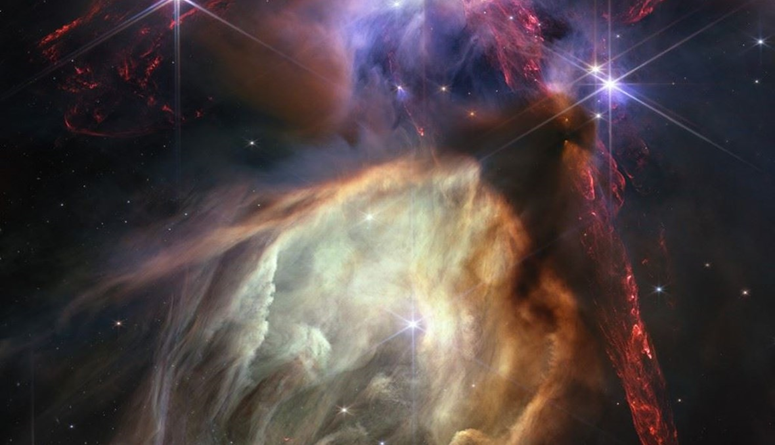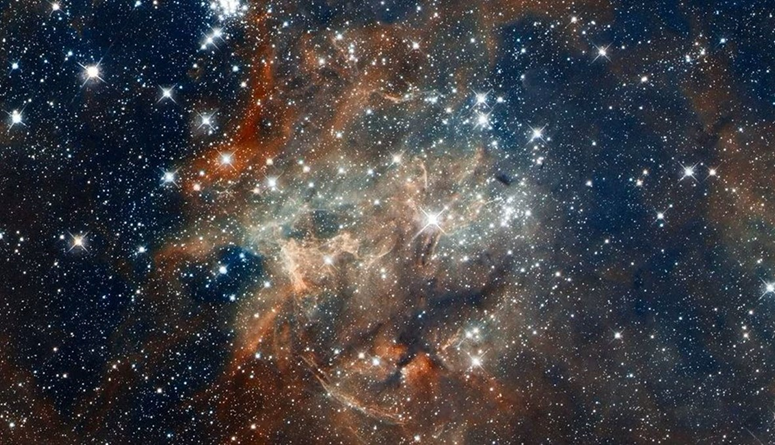On its first anniversary, the James Webb telescope gets closer to the stars and captures an amazing picture

A first-anniversary image released Wednesday, July 12, 2023, by the Space Telescope Science Institute's Public Outreach Office, shows what was captured by NASA's James Webb Space Telescope showing the birth of a star like never before. The subject is the Rho Ophiuchi cloud complex, the closest star-forming region to Earth.
The James Webb space telescope published, on Wednesday, a stunning new image showing about 50 newborn stars of similar sizes to our sun, which provides a clearer view of "a very short period in the life cycle of stars." This comes exactly a year after the publication of its first pictures of the universe.
A year after its first images of the universe , the James Webb space telescope revealed, on Wednesday, a stunning new image showing the birth of stars similar to our sun.
The image is dominated by jets of red hydrogen as a result of the emergence of stars emerging from their cocoons of dust in the nearest star forming region to Earth, 390 light-years away, located in the Rho Ophiuchi gas cloud.
This image, which includes about 50 newborn stars of similar sizes to our sun, allows for a “new clarity” view of “a very short period in the life cycle of stars,” according to Klaus Pontopidan, responsible for the James Webb science program at the Space Telescope Sights Institute. "Our sun went through a phase like this a long time ago," he added.
It is noteworthy that on July 12, 2022, "NASA" unveiled color images of galaxy clusters and nebulae that were the first to be captured by its new space telescope. These snapshots formed the beginning of the scientific operations of this telescope, which is a technological masterpiece and is located at a distance of 1.5 million kilometers from Earth.
"In one year, the James Webb Telescope changed humanity's view of the universe," NASA chief Bill Nelson said in a statement. And he stressed that "every new image is a discovery, which encourages scientists around the world to ask questions that they would not have dreamed of before, and to answer them."
NASA indicated that it would broadcast a video review of the discoveries of the first year.
The beginning is just that
James Webb has been dazzling astronomers with unprecedentedly accurate images since the start of his mission a year ago.

It has spotted the most distant galaxy ever discovered, measured for the first time the temperature of distant rocky planets, and observed young stars and black holes. There have been many scientific studies based on the observational operations carried out by him.
One of the main tasks of the "James Webb" telescope is to explore the early ages of the universe, while it also focuses on studying exoplanets outside the solar system. It should also help better understand the formation and life cycle of stars.
In addition to these accomplishments, James Webb's stunning images have made it available to the general public. In October, the first image captured by the "James Webb" space telescope was revealed of the "Pillars of Creation", which are huge columns of gas and dust filled with stars in the process of formation, located in the Milky Way galaxy at a distance of 6,500 light years from Earth, specifically in the Milky Way. The Eagle Nebula.
The James Webb telescope was sent by an Ariane 5 rocket at the end of 2021, a long journey launched by the US Space Agency (NASA) more than three decades ago. It succeeds the Hubble Space Telescope, which is still in service.
James Webb, which cost $10 billion, is distinguished from its predecessor by its surveillance technology.

The "Hubble" telescope conducts observations in fields where light is visible, while "James Webb" probes invisible to the naked eye waves of mid- and near-infrared, a beam emanating from every astronomical body, star, person, or flower. This allows it to detect much weaker lights, and thus allows it to see much further.
Because this wavelength is imperceptible to the human eye, the images are then "translated" into visible colours.
Klaus Pontopidan wrote on Twitter that the region captured by the telescope in the image published Wednesday "appears completely dark when viewed by Hubble."
James Webb has provided enough fuel to continue his mission for 20 years, during which he hopes to make more amazing discoveries.
Researchers around the world can book observing time with the telescope, whose program is carefully prepared in one-year segments.
"We selected an ambitious set of observations for the second year based on everything we've learned so far," said Jane Rigby of NASA's Goddard Space Center. "James Webb's scientific mission is just beginning," she emphasized.
Source : websites

